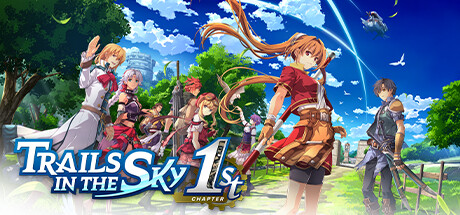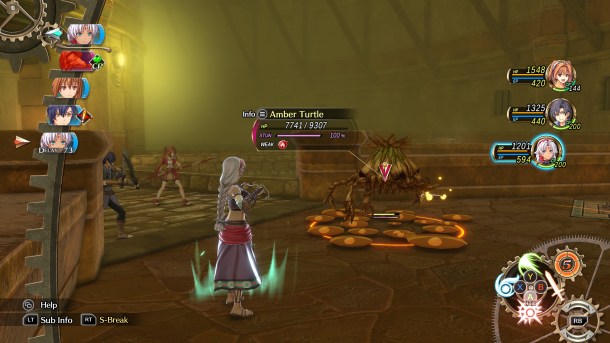 |
|
|---|---|
| Title | Trails in the Sky 1st Chapter |
| Developer | Nihon Falcom |
| Publisher | GungHo Online Entertainment America, Inc. |
| Release Date | September 19th, 2025 |
| Genre | RPG, Adventure |
| Platform | Nintendo Switch, Nintendo Switch 2, PlayStation 5, PC (Steam) |
| Age Rating | ESRB – T for Teen |
| Official Website | |
Years ago, I played through The Legend of Heroes: Trails in the Sky. The game holds a special place in my heart for introducing me to the world, characters and music of the Trails series. It laid the foundations for future Trails games and put me on the trail to being a lifelong fan. So, when Nihon Falcom announced a remake, Trails in the Sky 1st Chapter, I had mixed feelings. Of course, I was very excited to see this game in full 3D with much improved graphics and a more modernized battle system; however, I was worried when it came to the story. Sometimes a company might take liberties with the story when remaking a game, changing aspects that made it so great in the first place. Would the remake be faithful to the original’s story, or did it go down a different path? Did Trails in the Sky 1st Chapter surpass The Legend of Heroes: Trails in the Sky as a whole, or does the original still reign supreme? With much excitement, I revisit the origin of the Trails series and the country of Liberl in a new light.
Trails in the Sky 1st Chapter follows Estelle Bright and her adoptive brother, Joshua Bright, and their travels through the country of Liberl. Their story begins in the peaceful region of Rolent, as they work to become Bracers like their father, Cassius Bright. Shortly after they pass the exam to become Junior Bracers, Cassius leaves on a business trip and passes down some of his jobs to the siblings. After completing these requests and a few events, Estelle and Joshua hear some startling news: their father and the airliner he was aboard have gone missing. Using this as motivation, Estelle and Joshua set out on a journey to solve the mystery of their father’s disappearance, and also work their way up from being Junior Bracers to Senior Bracers.
The story was an enjoyable experience. In each region, there’s always a big incident Estelle and Joshua need to help resolve. During the course of the story, you start to get the feeling there’s a connection between all these incidents. Once that connection is discovered, it doesn’t at all feel out of left field. As the events of the story play out in your head again, you start to realize the seeds were planted throughout the duo’s adventure, and it’s very much an aha moment. It’s very well done. Another highlight of the story are our main characters, Estelle and Joshua. Estelle and Joshua complement each other very well. Estelle is more of the fiery go-getter type while Joshua is more calm and grounded, watching Estelle’s back as she marches forward. They make up for each other’s weaknesses, and this fact is even pointed out by other characters. It was great seeing these two grow with each incident they helped resolve, going from inexperienced rookies to trustworthy Bracers. Their relationship and how it blooms throughout the story is definitely one of the highlights.
Newcomers will find a lot to love with this story. It’s easy to get into, the many members of Estelle’s team are great and varied, and you don’t need knowledge of other Trails games to fully enjoy it. After all, it’s the first game in the series. As a series veteran, I also found additional ways to enjoy the story. It was interesting noticing references to characters and events that I otherwise wouldn’t have noticed when I first played. Of course, it’s not perfect. The biggest problem with the story is that it’s incomplete. It ends on a huge cliffhanger, and it really needs its sequel to help bring some closure. I’m hoping Nihon Falcom completes a remake of The Legend of Heroes: Trails in the Sky SC soon so players can experience this particular arc in Estelle and Joshua’s lives in full.
The gameplay in Trails in the Sky 1st Chapter is much improved from the original, particularly in its battle system. In The Legend of Heroes: Trails in the Sky, it was a very standard turn-based system without many of the additions and improvements seen in future games. For the remake, Nihon Falcom decided to utilize a hybrid battle system, which they first implemented in The Legend of Heroes: Trails through Daybreak. There are two types of battles you can have: Quick Battles and Command Battles. Quick Battles are the action portion of this system. You can perform normal attacks, Craft Attacks, and dodges. Normal attacks and dodges are exactly how they sound. Craft Attacks are basically strong attacks. They can only be performed when one of the sections of the Craft Gauge are full. Craft Attacks do more damage and stun enemies quicker than normal attacks. The Craft Gauge can be fully charged immediately by perfect dodging attacks. As you progress in the game, you also unlock Combo Attack. This is a powerful duo attack performed by both Estelle and Joshua. It uses one Brave Point (BP) from the Brave Gauge and has them perform a powerful wide range attack that almost instantly stuns any enemy that gets hit. With a press of a single button, Quick Battles transition into Command Battles.
Command Battles are turn-based and give you more options to take down your foes. Here, you have access to Arts (Orbal Magic), Crafts (Combat Skills), and the ability to guard, in addition to your standard attack. Arts utilize Energy Points (EP) and are comparable to magic in other RPGs. These range from abilities that can damage and debuff foes to support abilities that can heal or buff your party. More Arts can be unlocked as you equip new Quartz for each party member in the Orbment menu. It’s easier for certain characters to unlock more powerful Arts, but I’ll leave that to you to figure out. Crafts utilize Craft Points (CP). Like Arts, these can be separated between attack and support. In addition to normal Crafts, each character has an S-Craft. In this game, Estelle and Joshua have access to two of these while the rest of the party has one. These are your character’s ultimate ability, and so long as their CP is at 100 or higher, they can activate them at any time in the battle to help turn the tide.
If you attack a stunned enemy or if your character gets a critical hit, you can perform one of three Brave attacks: Follow Up, Chain, and Burst/Full Burst. Follow Up costs 1 BP, is the weakest of the three options, and can only hit one enemy. Chain costs 3 BP, is stronger than Follow Up, and has the potential to hit more than one enemy. Full Burst is the strongest of the three options but costs all 5 BP. It hits all enemies on the field and heals your party of any ailments. Your party also has access to Support Abilities. These activate based on what occurs in battle. For example, the Resurgence ability has a random chance of activating, once, if a party member falls in battle. A character with this ability will automatically revive the fallen member. More Support Abilities unlock as you fight in more battles. Every character also has access to an Overdrive which buffs certain stats and also heals any ailments. These can be activated when the Overdrive icon starts glowing, and you’ll usually hear the character say something when it’s ready to go. You can switch between Quick and Command Battles as much as you want, if it’s a regular battle. In boss fights and certain battles, you’re locked into Command Battles, which isn’t necessarily a bad thing since Command gives access to more powerful abilities.
Outside of battles, the gameplay is pretty much the same as it was in the original. You explore each region on foot, accept and report tasks at the region’s Bracer Guild, procure new equipment and items for your party, talk to the townsfolk and get their thoughts on current events, etc. But, Falcom also implemented some new features in the remake that have also been seen in more recent Trails games. First off, Falcom updated the minimap and map by adding markers. These markers show where main quests, sub quests, and other events can be found. This makes it easier to find where you need to go, and also makes finding missable items, such as the Carnelia books, much easier. In the original game, it was very easy to miss things. You had to go and talk to every single person and really go through areas with a fine toothed comb to make sure you didn’t miss anything. Next is the implementation of fast travel. In the original, you had to run everywhere, even to places you’ve already visited, and this could be a pretty big time consumer. Now, once you’ve visited certain areas like a city or checkpoint, you can fast travel to that location. Sometimes this function is locked due to the story, but most of the time it’s available. These two features, among others, made playing through the game much less frustrating and more enjoyable.
Gameplay as a whole is a big improvement from the original. The hybrid battle system appeals to both action and turn-based fans. While Quick Battles did not have as many features as Command Battles, the combat felt very smooth and pretty fast paced. Command Battles had a good amount of options, but weren’t so complex that you would feel overwhelmed. I appreciate how Falcom did not abandon turn-based battles. Seeing as how they also develop the Ys series, they could easily switch completely to an action-based system if they wanted to. Instead, Command Battles are still the focus while Quick Battles supplement the turn-based system. It’s as if Quick Battles are purposely limited so they don’t overshadow Command Battles. Honestly, it’s a well done system. Implementing fast travel and adding markers to the map made progressing through the game easier and more enjoyable.
I did have minor complaints in regards to the systems, though. In Command Battles, I wish the Arts menu was split into tabs for offensive and support Arts. The Arts menu is one long list and I had to scroll through the entire thing to find the move I was looking for. If you only had a few Arts, this wasn’t a big deal, but near the end game when you’ve unlocked many different Arts, that’s when it becomes a problem. For the map markers, while they are very helpful, I wish you could turn them off for certain quests. One of the quests you have to solve riddles, and the answer tells you where you have to go in the city to find the next clue. The map tells you where to go right off the bat, which defeats the purpose of the riddle. An option to turn off the markers during those types of quests would have been welcome. Despite these minor complaints, I had a blast playing through it, and I’m sure newcomers and veterans will enjoy the updated gameplay too.
Estelle and Joshua’s adventure continues! Read up more on this remake on page 2 ->








